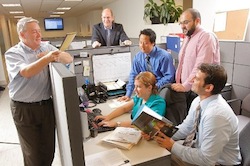Stiff: The Curious Lives of Human Cadavers, by Mary Roach, has long been one of my favorite books. It offers up oddly compelling and impossibly humorous accounts of bodies postmortem, including the various uses of human cadavers (in sum or in parts) in scientific research.
But I’ve never given much thought to my own participation as a postmortem donor. As an HIV-positive man, I am legally banned from donating organs—even to other HIV-positive people—and most cadaver programs aren’t exactly interested in bodies harboring a serious infectious disease.
A little known group is, in fact, interested in my body, or at least parts of it. It is the National Disease Research Interchange (NDRI), a nonprofit scientific organization based in Philadelphia that has made available more than 300,000 human samples that would have been otherwise trashed, incinerated or stored in formaldehyde on a dusty shelf. Roughly 5,000 scientists have made use of these samples in their research.
The organization accepts fluids, tissues and organs—“human biomaterials,” in NDRI parlance—from HIV-positive people, and it is actively seeking and welcoming donors, both living and dead, with the virus.
It turns out, all that’s needed on my end is a few minutes with a thin stack of consent forms and questionnaires. If I fill them out, I am able to help support lifesaving research in the event of my death or a surgery that produces scraps that would otherwise go to waste. But I have my uncertainties—so I decide to do a little research and check in with the folks at NDRI.
Where It All Began
NDRI was founded more than 30 years ago by activist and philanthropist Lee Ducat, who remains the organization’s president, sharp as a tack and driven to improve medical research.
Ducat’s dedication to biomedical research actually began 10 years earlier, in 1970, when she founded the Juvenile Diabetes Research Foundation after her son Larry was diagnosed with type I diabetes at age 9. Astonished at the lack of diabetes research—and funding for its scientists—Ducat, friends and family worked out of a cramped office in a Philadelphia suburb apartment building and managed to raise $10,000 to fund JDRF grants. Since then, the organization has raised more than $1.5 billion through its 115 chapters in the United States and affiliates in Australia, Canada, Denmark, India, Israel and the United Kingdom.
The importance of tissue and organ procurement came into focus for Ducat in 1980, in light of a challenge posed by Paul Lacy, MD, PhD, a leading researcher at Washington University School of Medicine in St. Louis who had been Ducat’s collegial friend for a decade. After studying the transplantation of islets—the cells in the pancreas that produce insulin—in animals, Lacy found himself in need of human pancreas for clinical trials. But there was no system in place to provide human pancreas, or any human biomaterials for that matter, in the quantities or qualities required by diabetes researchers.
 | |
| Lee Ducat, president and founder, NDRI. |
Soon enough, everything came together for Ducat, and NDRI was born. “We got a grant from Pew Memorial Trust in Philadelphia for $3.5 million to design the systems which would bring human tissues of all kinds to medical research. It was the beginning of the first program in the world to identify sources of human biospecimens, recover them in a quality way, process them in a customized way and bring those specimens to top laboratories.”
With funding from various branches of the National Institutes of Health, the pharmaceutical industry and general donors, NDRI continues providing pancreas specimens and islet cells from donors. It also recovers diseased and healthy organs and tissues from individual donors and organ procurement organizations for a variety of research purposes. In fact, NDRI’s ability to quickly provide quality human biomaterials to researchers in every major U.S. city has contributed greatly to scientific breakthroughs in the areas of diabetes, cystic fibrosis, pain management and a variety of rare diseases.
HIV Donor Program
Jump-started in 2000, NDRI’s HIV Tissue Procurement Program is one of the only national resources providing scientists with donated—and always de-identified—biomaterials from HIV-positive people.
According to John Lonsdale, PhD, NDRI’s research director, there is tremendous need for organ and tissue donations from individuals representing the spectrum of HIV disease—from people with early symptom-free infection or with late-stage AIDS, from people already on antiretroviral therapy as well as those who have yet to begin treatment, and from people with coinfections, such as hepatitis C virus, as well as those living with HIV alone.
“These donations are the only means by which scientists can get the human tissues needed for their studies,” Lonsdale explains. Tissues and organs are needed, he says, to further understand the biology of HIV transmission, the safety and effectiveness of new therapies, the neurological effects of HIV infection, the interactions between HIV and other viruses and various AIDS-related complications, notably Kaposi’s sarcoma and other tumors.
 | |
| John Lonsdale, PhD, NDRI’s research director (left) and several colleagues at the organization’s headquarters in Philadelphia. |
Also in demand are tissues and cells that are generally impervious to HIV treatment. Those are necessary for studies to better understand how to cure the disease once and for all. In this rapidly expanding field of study, Lonsdale says, scientists “have requested kidney, brain, blood, lymph node, thymus, tonsil and spleen.”
Three things determine which biomaterials are collected: the scope of consent provided by the donor, the tissues needed by scientists and the donor’s mortality status. For example, if someone consents to any and all anatomical gifts after death—and the next-of-kin agrees—NDRI technicians will harvest any human tissues.
NDRI also accepts tissues removed for medical reasons during a surgical procedure—such as skin and fat during plastic surgery; tumors; bone and cartilage excised during hip or bone replacement; even umbilical cords, placenta and amniotic fluid following delivery of a baby.
Diseased organs removed during transplant surgery are also needed. “The quality of explanted organs [from living donors] is generally much higher than that of equivalent organs from [deceased] donors,” says Lonsdale. “They can be recovered and preserved much faster, are recovered [under sterile conditions], and the viability of the cells is very high.” He adds: “Organs such as liver which are coinfected with hepatitis C virus are of particular interest.”
To date, nearly 200 HIV-positive people—both living and deceased—have donated biomaterials to the program. Many more are needed, however. “Every donor is unique, and researchers’ projects all have different requirements, such as age, race, sex, comorbidities, medications and tissue types,” Lonsdale says. “A donor that is ideal for one study may not be suitable for another. Experiments also require tissues from multiple donors for the results to be significant.”
To grow, however, NDRI will need additional funding. According to Ducat, the HIV donor program is operating on a shoestring budget of $200,000, made possible with a grant from the National Institute of Allergy and Infectious Diseases (NIAID). “This program needs to advance quickly, and the only way is with additional funding,” Ducat says. “At present, we have no grants from [the pharmaceutical industry] for HIV research. I have learned over the years that funding does make a difference. I am sure if we could get increased support for this program, we could impact HIV research even beyond the breakthroughs we have already had.”
Donating Made Easy
Enrolling in NDRI’s HIV donor program requires little more than a phone call or email to the organization (see below) to request a donor packet (also available online). Included are two consent forms—one for surgical donations, the other for postmortem donations—specifying which tissues and organs you’re willing to donate, along with a simple questionnaire asking basic information (age, race, gender, HIV infection duration, latest CD4 cell counts and viral load, current medications, etc.).
What’s really important, Ducat stresses, is communication: If you wish to donate biomaterials from a surgical procedure, tell your surgeon that you’re an HIV research donor and notify NDRI so it can coordinate with the hospital team.
As for postmortem donations, it is essential that family and loved ones, as well as personal doctors and attorneys, be told of your wishes and that they comply with your request. “We rely on family members to contact us as soon as death occurs or is imminent,” Ducat says. “We can lose valuable time if we need to counsel family members about a donor’s wishes.”
Some fragile tissues, like the eyes or heart, need to be recovered within a few hours after death; brain tissue, bone and other more durable tissues are sometimes viable up to 12 to 24 hours after death.
It is important to note that NDRI arranges for the recovery of tissues and organs for research, unlike medical institutions that use complete cadavers. In turn, NDRI is not responsible for disposing of your body, nor is it able to perform or help fund cremation, memorial or burial services. And while NDRI stresses that neither live nor postmortem donation costs are the responsibility of the donor, there is no financial compensation for participating in the program.
Ducat and her NDRI colleagues also stress that being a donor need not affect your funeral wishes—for example, an open-casket viewing and burial. “A traditional funeral service can still take place, even though many organs and tissues have been donated. Highly skilled professionals perform the recovery procedures, and the appearance of the donor is unchanged. Unlimited donations are usually offered when a cremation is desired.”
Sign on the Bottom Line
“Our mantra at NDRI is, ‘Human tissue is the path to discovery,’” Ducat says. “After witnessing advances in cancer, diabetes and in cystic fibrosis, with over 100 advances published each year based on the human tissue NDRI provides to scientists, we know how valuable the donation of diseased human tissue, from surgical and postmortem donors, is to the laboratories of the world. Human tissue is the path to discovery!”
Ducat is right, of course, and it makes little sense to deny HIV cure-hunting, infection-preventing and complications-treating scientists pieces of me that would otherwise end up on a cold surgical suite floor or turned to vapor and ash following my cremation. So I sign on the bottom line. Even if I fail to achieve much of anything else in terms of giving to humanity, there’s always the hope the eventual slices or dices of me will yield something amazing for generations to come.
To be an organ and tissue donor for HIV research, call or write NDRI at: 800.222.6374 or HIV@ndriresource.org. In fact, NDRI gladly accepts any and all donors to help advance research for a variety of common and rare diseases—call the toll-free number to learn more.






21 Comments
21 Comments